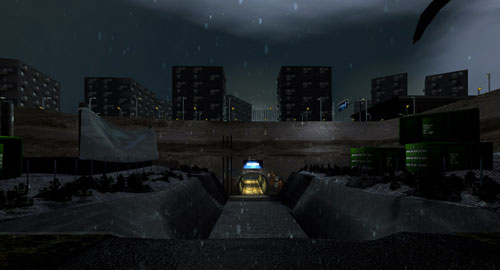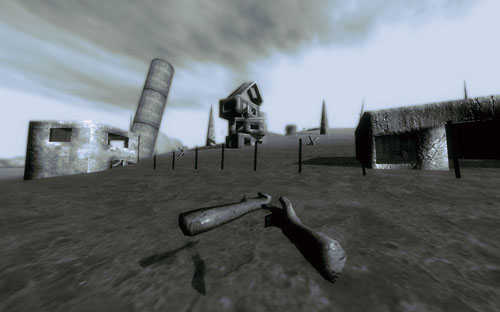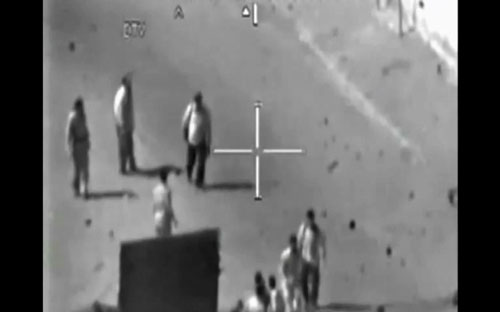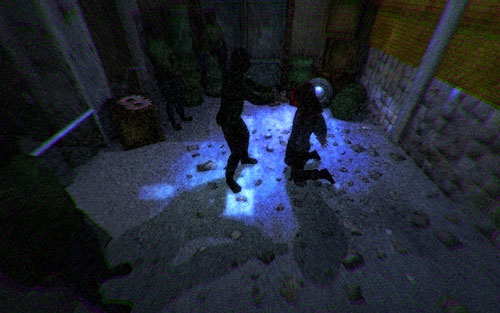What happens when we live our lives through a videogame interface? In May 2007, the Iraqi-American artist Wafaa Bilal created a performace called Domestic Tension, in which he lived for one month inside the now-defunct Flatfile Gallery in Chicago. In the gallery was the artist’s bed, desk, chair, computer and a loaded paintball gun connected to a web server. Anyone could visit a website connected to the exhibition, and once there, aim and shoot the paintball gun at the artist in the gallery. The question asked by Bilal was, what happens to our emotion and empathy for other humans when we are using an interface on the Internet? Will a visitor hesitate to fire the gun if they are aiming at a real person, or will the videogame-like interface create a sense of distance from the human being behind it? After a month, 60,000 people from 130 countries had shot around 65,000 paintball blasts at Bilal, which I assume answers the question.
Another artist interested in videogame interfaces is the Swedish art student Mikael Vesavuori, from Valand Art School in Gothenburg. In his exhibition It’s All Fun and Games Until Someone Blows Their Brains Out, he examines how interfaces affect our understanding of space and experience. I conducted this interview with him in early January 2012.
Mathias Jansson: Can you tell me about the project It’s All Fun and Games Until Someone Blows Their Brains Out?
Mikael Vesavuori: The works in “It’s All Fun and Games…” explore how interfaces are intimately linked to our understanding of mediated experiences and the possible spaces in these. By these interfaces our usage and entry point into something other is shaped and defined. That other can be both a digital world as well as the everyday common realities of life. A particular focus is, as the title implies, on violence and the role of these interfaces in making those acts, passive or active, be possible to execute at all. When I began paying more attention to the physical layer of interaction rather than just the on-screen events, I got increasingly concerned about the perpetuation of violence in the tactile dimension. Instead of creating gameplay inside magic circles and other such constructs of ludo[ideo]logy I want to emulate bare-bones conditions that make the violence machinery jump to life. So, it’s not so much about making rule-based games one can win but to create a space in which the broken relationship to a very powerful tool – in essence a creator of its own kind of reality – becomes both the critiqued object as well as the main “philosophical” focal point. I draw parallels to Heidegger’s notion of “ready-to-hand” to think about this being in the world via something, never being truly distant from the practical, phenomenological existence among things. For me, this is far less trivial than may be thought about in an everyday situation, almost in fact, traumatic I think.
MJ: What is the main idea/issue with the project?
MV: The works are set up for short sessions. I guess they are pretty loaded – even blunt, sometimes – but are, I hope, consistent with my sense of how (most problematically) mainstream games “hijack” controls and agency from the player, enforcing it on a set narrative framing. Ergo: we have war crimes that are never war crimes, but heroism – a similar doublespeak that goes on in politics. That’s why I wanted to do something similar but much more extreme, less unintentional, kind of a hostile takeover where the interface IS the game. There is probably a sick humor buried in all of this, but it’s so close to heart I am wary of saying that’s the case, myself. I blame it on my Finnish side.
MJ: How were the games made? Which tool did you use?
MV: The games – although I am hesitant to call them such – were made with Unity3D, an engine I’ve been using since the days when it was much, much smaller in impact than today. In a weird way, we have both kind of grown up together: it becoming more capable in comparison to its bigger brothers (and sisters), and myself becoming more open to the kind of work such an engine can spawn. It is a wonderful tool for someone like me, who has no proper background in computer science, because it removes the heavy lifting involving in creating, say, a custom renderer. Other tools include Blender, Adobe products like Photoshop and Premiere, Logic Pro and MonoDevelop. All pretty standard stuff, really. Except for Blender, which is not only extremely polished these days but also free, I’ve looked a lot into the open-source space, especially at Gimp and Audacity but I feel both have a long way to go until they can go head-to-head with the giants like Blender has done. Victoriously, even, in my opinion. Regardless, I sincerely believe that the fact that one can get into previously really demanding things like 3D games and complex graphics either cheaply or for free today has been liberating in a sense that has only one comparison. I would say that the proliferation of cheap, good production tools in the last five years has been an equally important event for interactive/game-based art as the effects of Duchamp’s Fountain was for the rise of contemporary art.
MJ: There are four games in the series; what is the difference between the games? Are they four separate games or four parts of a bigger context?
MV: Three of the works, all of them except Not a Place of Honor, originated during late 2010/early 2011 and were initially free-standing works. They are all different in that they rethink various genres and their conventions and add disturbing narrative framing to them to contextualize the sparse interactions allowed. Because they were first conceived of as sort of anti-games – with rules, some win/lose idea etc. – elements have over time been trimmed to a tighter core and narration has become installation context instead. Consider that the original Equalizer was the only decidedly non-game work of the trio. Now all of them are similarly reduced, yet interactive, but outside what would comfortably be called a “game.” This is a suitable change and more correlative to the experience I wanted the works to give.
All of the singular works have to various extents further evolved as I approached to remodel them this fall to comply with the above-mentioned sense I had of the role of interface. This was all pretty obvious when seen together – it was almost stupid to not put them side-by-side as well as giving me time to polish things I was never at all satisfied with, other than conceptually. Not a Place of Honor was added to the mix when I noticed that I could not plainly modify a commercial game I was critiquing last summer, so I had to make it myself thus expanding on it as well. Not a Place of Honor adds flavor and a distinctly different feeling to the collection as well. So the official story today is that they are now linked via the main issue I am exploring in the exhibition, even if they were once separate and still retain some variety in their respective configurations.
MJ: One major issue in the project is what happen to our understanding of reality and our empathy to violence when we more and more uses virtual interfaces? How do you see on this development?
MV: The piece Equalizer uses footage from both classical and modern conflicts, so there is a crossing between imagery emphasizing the raw, “personal” battlefield and then those from hovering gunships or drones in modern-day Iraq. If we look at someone like Harun Farocki – with his Serious Games works, for example – this new optics of violence begins to form new subjects for whom violence is no longer a physical encounter. It does seem that the real consequences of virtual violence has the effect of creating subjectivities that accept this particular apparatus because the actual battle is secret, covert and without collateral damage to human dwellings – as nations like Iraq and Afghanistan have been reduced to something other than an actual place, being an instance of the concept of war instead (on which Not a Place of Honor comments). Further, that modern war and violence (physical or mental) in general seems to derive from extreme surveillance, not unlike the instant perspective shifts in many games, a tradition born from cinema, probably makes it impossible for many to imagine how real violence looks and is felt. Something the soldiers of WWII could likely not even imagine.
Michael Haneke is someone I deeply admire. Similar to him, I want to make violence dull, slow, bitter and paralyzing rather than necessarily visceral and simplistic as it is today. Without being moralistic, violence in games definitely needs to concern more of the surrounding factors as well, because no one is mixing up fictional violence, or is even shocked with it. It needs to be felt to be understood. While not quite there yet, I’m starting to think of how Freire’s pedagogy of the oppressed and Brecht’s theater might be used to good effect in this area. Also, there is probably a lot that can be explored when artists collaborate with people in science and psychology, as videogames are extremely potent “biological modifiers” and really work on all kinds of levels. It is not at all strange that there is serious corporate investment in gamification schemes and so on. But those same companies would be hard pressed to put MA-18 tags on those products even if they also concern some degree of (actual) coercion, much worse than merely fictional death and gore.
MJ: How do you see on videogames as an artistic medium and tool? What can videogames add to your artistic practices?
MV: Games are never just games, just as lived life is not a commodifiable, indistinct, enumerable asset. I like to think about the notion of “games” in a far wider meaning, like Fluxus or the Situationists did, with a “game” constituting something realistically-grounded-and-psychologically-enforced rather than a self-contained magic circle. This is probably the largest issue at hand in advanced game design, indie, art or commercial or otherwise: how to expand this notion and be able to talk about it in a concise manner. Generally speaking I would say that this is the frame I try to work in, how things, messages and media create and expand or constrict our lived reality. So they can’t be without each other. Digital games are interesting for me because of how we project ourselves or make complex structures observable and possible to, most of the times, affect somehow. With few exceptions, this is more than I can say about most regular people in an actual situation. I might add that with this exhibition I am acutely aware that I am only scratching on a few simple notions of how physicality impacts digital scenarios and vice versa – there is still lots to uncover.
Because the digital technologies used are at the core of this aesthetics, made visible, they have little to do with the specific structures of a finished product stacked on top of it, such as the game framework. Using that tech to pervert what could have been done with it, or already was before (as in hacking), I think it is more productive to simply look at the collective work being done as highly media-literate detournement and interrogation of these extensions, tools, cognitive add-ons or what-have-you. They are the things with which we live and understand large chunks of what we encounter: it is only natural to see impossibilities become suddenly possible when processing power is getting better, web connection is available 24/7 (in the North, at least) and these devices become more intuitive to rework, build or otherwise engage with artistically. People are becoming infused with technology, merging with it, if not physically then at least cognitively. With the risk of making myself regret this, I feel that an art today that does not involve its publics/audience in a considerable manner makes little sense. People are, ironically, becoming the new old technology (new media anyone?) so what was before a techno-centric approach can more than ever start looking at the audience for real. It is not at all far-fetched to see how roots once based in games/game tech/gameart are sprouting to other connected art forms like concept art, architectural art and performance. The Situationists would probably be happy today. Or maybe not. Well, for what it’s worth Apple banned the Situationist app. Perhaps that is another irony in and of itself.







